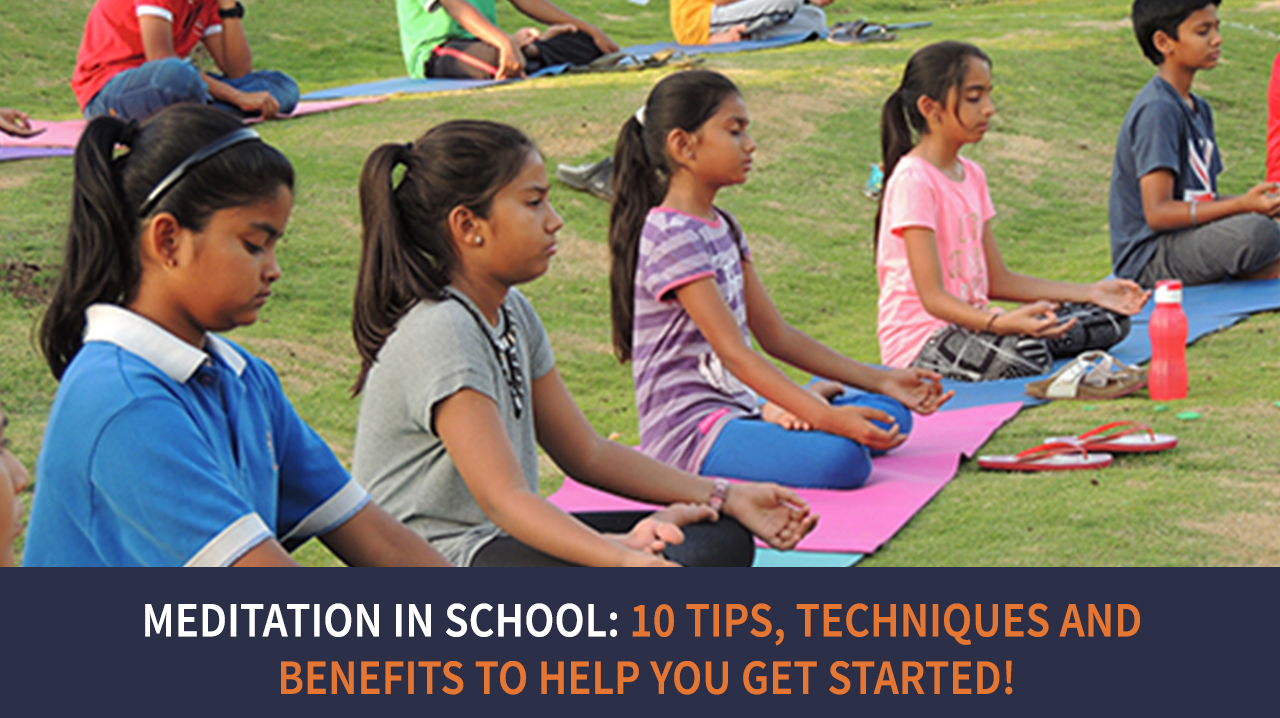Meditation in School: 10 Tips, Techniques and Benefits to help you get started!

With the fast-paced academic schedules, and pressure to perform well, the stress levels in students are on the rise. As a parent, you want your child to be relaxed, optimistic and focused to ace their subjects and score well. Do you know there is a wonderful way to reduce stress, boost concentration and create a mindful classroom experience for students? The simple answer to this is – meditation in school. In this blog, we share tips on how schools make meditation schedules effective and beneficial for students. If these inspire you, you may look to instil brief medication hours within your child’s schedule.
1. Selecting the right time
Schools, such as MIT Gurukul, choose a time for meditation when teachers and students:
- can relax without any disturbances
- can develop it into a habit by keeping this slot fixed
- hone a calm persona and a fresh mind to concentrate on studies
We avoid doing this during the last periods because everyone is tired and eager to reach home and rest. MIT Gurukul, like many good schools in Pune, has found that the time after the assembly or morning break might work wonders for a meditation session.
Also Read
2. Keeping it short and effective
At MIT Gurukul, one of the top-ranked schools in Pune, we introduce meditation sessions to young students by keeping them short and effective at first. Starting with two minutes in grade 1st, we then scale meditation sessions to fifteen-minute slots by secondary and high school. You can apply this meditation schedule by keeping the session for five minutes for primary school children to twenty minutes for your high school child.
3. Setting some prompts to begin the session
MIT Gurukul employs creative communication patterns to get students to like meditation sessions. We avoid saying, “Good morning, class. Let’s start our meditation for today.” Instead, we say, “Alright, everyone, please sit comfortably and relax your shoulders. You can keep your hands on your desk or your lap. Now close your eyes slowly and take a deep breath. We are going to relax our minds and develop our concentration to study well.”
Now that you know the tips to get started, let us look at 3 useful techniques of meditation that we deploy in school to benefit your child:
Also Read
1. The famous balloon technique:
We ask our students to imagine a balloon inside their tummy. Let them inhale and hold their breath till three counts, imagining that the balloon is getting inflated. Then we instruct them to breathe out as if the balloon is slowly getting deflated. This helps release stress, and whenever they are upset, they can practice this with an imaginary balloon of their favourite colour.
2. Connect with nature and appreciate it
We take our students to the school garden and let them listen to the chirping of birds in silence or the calming sounds of the Mula Mutha river. At home, you may also sit down with them, touch the green blades of grass and meditate, or sit in the balcony early morning and meditate surrounded by plants and birds.
3. Use of guided relaxation method
Many times we play guided meditation audio in the class and help students hold their thoughts and relax their brains. We let the voice guide the students through the session, speaking calmly and taking it slow. The medication instructor may ask the students to let go of the tension in their body parts one by one. Then he asks them to imagine a peaceful place and guides them through the process.
With the help of such techniques, MIT Gurukul, an IB (International Baccalaureate) school, has made meditation a priority. But why do the best IB schools in the world encourage this practice? Here are 4 benefits that explain this:
1. Intelligence: The IB MYP (Middle Years Programme) fosters intelligence through a well-balanced curriculum. Meditation improves the brain and academic performance. Therefore, IB teachers and students greatly benefit from it.
2. Calmness: Meditation helps teachers and students to calm their minds and also reduces stress, depression, anxiety, and ADHD symptoms in students.
3. A healthy heart: It has been found that those who meditate regularly are less prone to cardiovascular diseases later in life.
4. Mindful choices: Teachers and students who meditate remain mindful throughout the day, and thus teachers can teach better while students can learn well.
Also Read
These benefits help our teachers at MIT Gurukul to be more mindful and enjoy their teaching experience. At the same time, our students learn to cultivate awareness, affection and empathy through this simple initiative. Therefore, we highly recommend meditation in every school, and at each home, for a remarkable journey of positive transformation. If you would like to discover more about what MIT has got to offer, visit our website.


